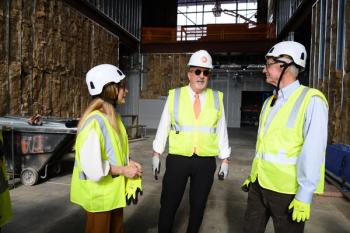
Hospital Design Planning Workbook: Design and construction timeline
Track your progress and stay on top of key project deadlines with this list.
Untitled Page
Here's a breakdown of key points in the building process, and when they need to be completed. To download a PDF version of this checklist,
30 to 36 months before move-in
Brainstorm motivations for building
- Identify your practice philosophy.
- Analyze your existing and future market.
- Estimate growth in income, staff, veterinarians, and services.
- Identify additional areas of potential growth.
- Develop a listing of project goals and needs.
- Gather information pertaining to the construction process.
- Attend the Veterinary Economics Hospital Design Conference.
24 to 30 months before move-in
Assemble your initial design team
- Management consultant
- Accountant
- Architect
- Real estate broker
Investigate your development options
- Compare and contrast building new, renovating your current space, and leasing space.
Build new
- Identify your desired location based on the market and projected city growth.
- Identify specific sites in your target market area.
- Compare and contrast sites based on cost, development potential, visibility, and constructability.
- Investigate a specific site.
- Confirm site size and identify easements.
- Confirm the availability of utilities: sewer, water, power, and gas.
- Confirm that the site is zoned correctly.
- Identify constraints that may impact development: soils, wetlands, or hazardous materials.
Renovate or expand your existing facility
- Determine the desirability of your existing facility in terms of community and market growth.
- Investigate the viability of renovating or expanding on the existing site.
- Confirm site size and identify easements.
- Confirm the availability of utilities: sewer, water, power, and gas.
- Confirm that the site is zoned correctly.
- Identify constraints that may impact development: soils, wetlands, or hazardous materials.
- Investigate the viability of renovating or expanding your existing building.
- Investigate the viability of existing structure, HVAC systems, roofing—architect or contractor can assist.
Lease space
- Identify your desired lease locations based on the market and projected city growth.
- Identify specific leasehold spaces that are available in your area.
- Compare and contrast leasehold spaces based on cost, market, configuration, and visibility.
- Confirm that leasehold is adequate in size.
- Confirm that leasehold space is zoned properly.
- Confirm the availability of utilities.
18 to 24 months before move-in
Investigate your project feasibility
- Identify your project size and scope.
- Meet with your architect to develop a listing of required spaces and site needs.
- Cross-check your listing of required spaces with the available site, building, or lease space—architect can assist.
- Identify construction cost based on listing of spaces.
Identify balance of project costs
- Evaluate site acquisition, equipment, design fees, and development costs.
- Compare project costs with available funds.
- Review funding options with your accountant, management consultant, and lending group.
- Secure a preliminary commitment for financing.
- Review your available cash and verify your project timeline with required target dates.
Initiate site purchase or lease negotiation
- Note: If needed, initiate your planning and zoning applications. This process can require four to 18 months, so plan accordingly.
- Hold a preliminary meeting with city officials to identify issues, process, and timeline.
- Meet with your architect to identify upcoming tasks.
- Hire a civil engineer to assist in the application process.
- Civil engineer, architect, or planner develops required exhibits for application.
- Complete application for city or county zoning.
- City or county reviews application and requests supplementary information.
- Obtain zoning approval.
18 months before move-in
Begin schematic design process
- Architect develops initial facility design: schematic floor plan, exterior appearance, and site layout.
- Gather information to begin drawing production.
For a new or existing site
- Obtain a current metes and bounds survey.
- Complete an improvement and topographic survey.
- Conduct a soils test.
- Complete a level one EPA study to identify potential hazardous materials on site.
- Develop information on existing buildings to remain.
- Develop plans for structural framing, building systems, utilities, and sewer.
For a leasehold space
- Obtain accurate drawings for potential lease space.
- Obtain accurate information about existing utilities (power and sewer) and existing HVAC.
- Sign off on schematic drawings.
- Retain a civil engineer and landscape architect to develop site drawings.
- Obtain preliminary pricing from your contractor based on schematic drawings.
- Confirm project construction cost and viability—architect, accountant, and management consultant can assist.
12 to 18 months before move-in
Produce working drawings
- Authorize architect to proceed with working drawings.
- Provide additional detailed information to architect on equipment, cabinetry, HVAC, electrical requirements, and interior finishes.
- Architect forwards information to building consultants to produce structural, mechanical, and electrical drawings.
- Investigate retaining a contractor on a preliminary basis.
- Contractor reviews in-progress working drawings produced by architect for preliminary budget purposes.
- With architect, review drawings for compliance before release for bidding and building department.
10 to 12 months before move-in
Complete bidding, building application, and financing process
- Architect releases completed drawings for bidding and building department application.
- Architect gives final working drawings to contractor for pricing.
- Submit final working drawings to building department.
- Building department reviews application and requests additional information.
- Finalize financing requirements with bank.
- Work with bank on appraisal process.
- Building department releases drawings for construction.
- Contractor provides final bid.
- Owner and contractor review cost-saving alternatives.
- With contractor, finalize construction contract.
8 to 10 months before move-in
Oversee facility construction
- Review construction schedule with contractor and architect.
- Contractor begins construction.
- Architect approves pay requests to contractor on monthly basis.
- Architect and contractor develop punch list and wrap up construction.
- Contractor corrects punch list items.
- Architect executes certificate of occupancy.
- Take over utility bills and building insurance.
- Contractor gives owner warranty and service manuals for facility.
- Release final payments to contractor.
Move in to facility
Develop move-in and transition plan
- Move in.
- Retain HVAC contractor to provide ongoing service and maintenance.
12 months after move-in
Perform warranty walk-through
- Conduct warranty walk-through with architect and contractor.
- General contractor makes necessary repairs.
Newsletter
From exam room tips to practice management insights, get trusted veterinary news delivered straight to your inbox—subscribe to dvm360.




